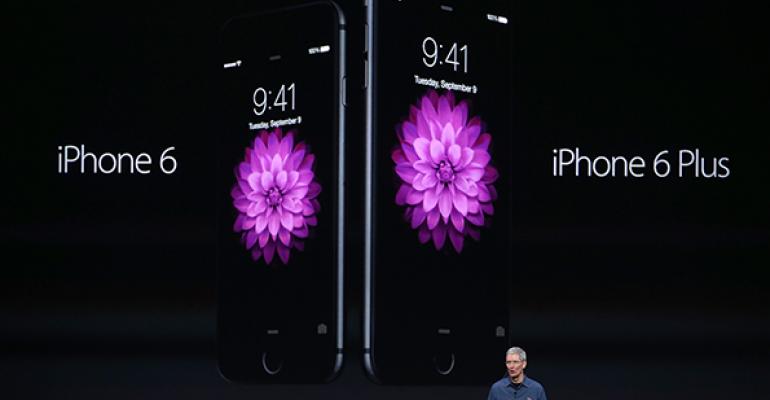Welcome to the year of the big phone. Thought we were going smaller? Think again. And while we’re unlikely to upgrade our tablets every time a different flavor comes out, smartphones are another story. Give us a different interface or a shiny new feature, and we’re hooked. From Apple’s iPhone 6 Plus to Samsung’s Galaxy Note Edge, here’s what you’ll likely want to play with next.
Apple 6 Plus: How Big Do You Want to Go?
Apple’s new release, the iPhone 6 Plus, has a 5.5-inch screen but it's the thinnest phone they’ve made yet. There’s an ion-strengthened glass screen and a new version of iOs with the ability, among other features, to add audio and video to text messages.
The new chip, the A8, makes the new iPhone 50 percent faster than the original, and is 50 percent more energy efficient—nice for supporting the huge display that can eat up a lot of battery power. The new device also features a barometer and a new health app with the ability to tell whether you’re cycling, running or walking and estimate how far you’ve gone. There’s also improved Wi-Fi (three times faster) that seamlessly jumps to cellular—great for office use when your network may not reach you at your desk.
Another big reveal? A new payment system, Apple Pay, will make it easier to swipe and go. It integrates Touch ID security and a new chip to encrypt and authenticate. You can add new cards on your own, and Apple verifies with your banks and credit card company (starting with American Express, Mastercard and Visa) without storing numbers.
The company also revealed the Apple Watch this afternoon. Starting at $349, the device won’t be out until early next year. Apple is so bullish that Jony Ive, senior vice president of design, allegedly said that Switzerland is in trouble. The square-cased silver mini device will come with colorful plastic bands (think Swatch), and a metal Rolex-like one as well. It will sync with the iPhone, and has a dial on the side, called a digital crown, which is actually the digital stylus for the device. The screen is a sapphire display that can pick up not only touch, but force. It can recognize differences between tapping and pressing, changing how you access controls.
Apps will be usable on the Apple Watch, and you can zoom in and out on images and details. It can be used for text messages, email, exercising, calls, and Siri. You can also send a quick sketch from one Apple Watch to another Apple Watch through a connection between the devices. And the device will even physically react, beating and vibrating.
Will you want to hold off on upgrading your smartphone for the Apple Watch? Of course not. For starters, Apple Watch requires an iPhone to work. But more importantly, their strengths are different: A wearable is going to be a game changer. But for a device that packs any computing power (think looking at client documents and plan notes), a smartphone, or phablet as this new generation is called, is going to remain crucial for work now. You can pick one up starting Sept. 19 (pre-order Sept. 12), when both the 6 Plus and its sister hits stores, starting at $199 for the 6 and $299 for the 6 Plus with a two-year contract.
Galaxy Note Edge: Fun Spills Over
Samsung beat Apple to the punch with the unveiling earlier this month of its Galaxy Note Edge aimed at Android users. We heard about a flexible screen, an improved handwriting feature, and a phone the size of a paperback book. It’s all of these.
The Edge has a screen that literally curves over the side like a mini-waterfall, acting as a ticker for notifications. It’s fat too—about 8.3 millimeters, or one-third of an inch thick with a 5.7-inch screen. (That’s bigger than the iPhone.) The edge of the screen stays lit at night, and turns into an alarm clock, among other features. It also has a pen that makes handwriting more readable and pleasing to the eye.
Expected to drop sometime before the end of November, the Edge is likely to be priced around $350 to $450 with a contract. Verizon is offering interested customers a chance to sign up early for first news when the phone drops.
Nokia Lumia 730: The Selfie Phone
Microsoft’s new phone, the Nokia Lumia 730, is a more budget-friendly option. The Nokia Lumia 730 has also been tagged the “selfie phone,” for its front-facing camera, which is better suited to taking pictures of yourself for Facebook or for Skype calls with clients.
Microsoft’s purchase of Nokia this year gives the tech giant another avenue to push its operating system, and those using Microsoft's Surface will recognize the tiles on the Lumia 730. While not going to set off a series of oohs and aahs like Edge, the phone does come in a rainbow of colors, has a curved back and frankly feels nice in the hand. It’s expected to run less than $300.
Google's Ara: Snap and Go
If the curved screen doesn’t do it for you, how about a phone you build yourself—with LEGO-like blocks that snap together and configure the way you want? Meet Google’s Project Ara, which is well past concept stage and has already launched a challenge to developers to create new modules for the proposed smartphone by the end of October.
Still deeply in the alpha stage, Project Ara is likely to be a hit with those who want to cherry pick the features they want and don’t want.





